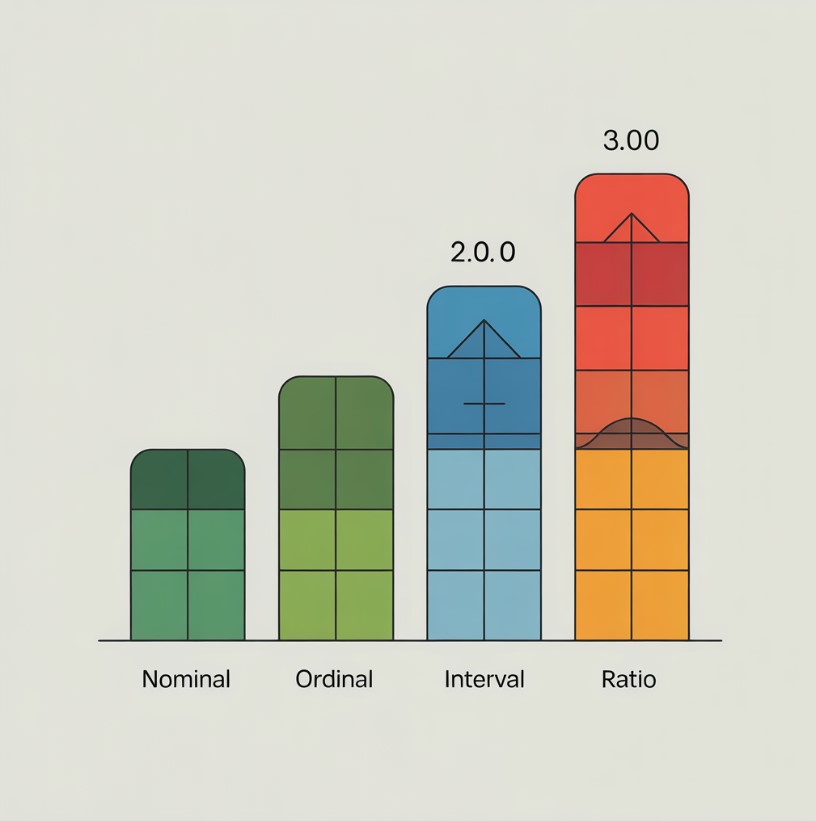Contents
The four levels of measurement—nominal, ordinal, interval, and ratio—are a classification system that describes the nature of information within the values assigned to variables, dictating which statistical analyses are appropriate.
Every dataset contains information that can tell a story. The complexity of that story is determined by the data’s level of measurement. These levels, a concept developed by psychologist Stanley Smith Stevens, provide a framework for understanding data. Moving from a simple list of numbers to an accurate analysis requires knowing these four levels. Let’s explore each level, from the simplest classification to the most detailed measurement.
Nominal Scale: The Level of Classification
The nominal scale is a level of measurement that categorizes data into distinct groups without any quantitative value or order. It is the most basic level of measurement. This scale answers the question, “What kind of thing is this?” by assigning items to named categories.
With nominal data, the categories have no logical sequence. One category is not “higher” or “better” than another; they are simply different.
Examples of Nominal Data:
- Types of Trees: Oak, Pine, Maple, Birch
- Departments in a Company: Sales, Marketing, Human Resources, IT
- Eye Color: Blue, Brown, Green, Hazel
- Political Affiliation: Republican, Democrat, Independent
Analysis of Nominal Data
You can analyze nominal data by counting the frequency of each category (the mode). For example, you can determine that “Marketing” is the largest department by counting the number of employees. However, you cannot calculate a meaningful average or rank the departments mathematically.
Ordinal Scale: The Level of Rank and Order
The ordinal scale is a level of measurement that categorizes and ranks data in a specific order. While this scale shows the sequence, it does not show the magnitude of the difference between ranks. It tells a story of hierarchy or preference.
You know the order of finishers in a race (1st, 2nd, 3rd), but you do not know if the winner finished 1 second or 10 minutes ahead of the second-place finisher. The intervals between the ranks are not equal.
Examples of Ordinal Data:
- Customer Satisfaction: Very Unsatisfied, Unsatisfied, Neutral, Satisfied, Very Satisfied
- Education Levels: High School Diploma, Bachelor’s Degree, Master’s Degree, PhD
- Race Results: 1st Place, 2nd Place, 3rd Place
- Income Brackets: Low, Middle, High
Analysis of Ordinal Data
With ordinal data, you can determine the mode and the median. You can tell a story about sequence, such as “Her performance rating improved from ‘Good’ to ‘Excellent’.” You cannot, however, perform mathematical operations like addition or subtraction because the differences between ranks are not quantifiable.
Interval Scale: The Level of Equal Differences
The interval scale is a level of measurement where data is ordered and the difference between any two values is equal and meaningful. This scale tells a story of measurable change. The key characteristic of the interval scale is its arbitrary zero point, which does not indicate a true absence of the measured attribute.
For example, 0° Celsius does not mean there is no heat; it is simply a point on the temperature scale. Because the zero is arbitrary, you can add and subtract values, but you cannot multiply or divide them.
Examples of Interval Data:
- Temperature: Celsius or Fahrenheit scales
- Calendar Years: 1990, 2000, 2010
- IQ Scores: A score of 0 is not an absence of intelligence.
Analysis of Interval Data
You can calculate the mean, median, and mode of interval data. You can tell a precise story about the degree of difference, such as, “The temperature increased by 15 degrees.” You cannot make ratio statements like “20°C is twice as hot as 10°C” because there is no true zero.
Ratio Scale: The Level of True Proportions
The ratio scale is the highest level of measurement and possesses all the characteristics of the other scales: categorization, order, and equal intervals. Crucially, it also has a true and meaningful zero point. A true zero indicates the complete absence of the quantity being measured.
This allows for the most complete story, including proportional relationships.
Examples of Ratio Data:
- Height and Weight: 0 kg represents a true absence of weight.
- Bank Account Balance: $0 means there is no money.
- Age: 0 years represents the moment of birth.
- Time: 0 seconds means no time has passed.
Analysis of Ratio Data
The ratio scale allows for all statistical analyses. You can add, subtract, multiply, and divide values. This enables powerful ratio comparisons, such as, “Company A’s revenue is half of Company B’s,” or “This car is traveling twice as fast as that one.”
Summary of the Levels of Measurement
The level of measurement you use dictates the statistical analysis you can perform. The table below summarizes the four levels.
| Level of Measurement | Key Characteristic | Example | Permissible Statistics |
|---|---|---|---|
| Nominal | Categories without order | Types of fruit (Apple, Banana) | Mode, Frequencies |
| Ordinal | Ordered categories | Education level (Bachelor’s, Master’s) | Median, Mode, Ranks |
| Interval | Ordered, equal intervals | Temperature in Celsius | Mean, Median, Mode, Addition |
| Ratio | Ordered, equal intervals, true zero | Height in centimeters | All statistical operations |
Frequently Asked Questions (FAQ)
Q: Who created the levels of measurement?
A: The psychologist Stanley Smith Stevens developed the theory of the four levels of measurement in 1946.
Q: Why is it important to know the level of measurement?
A: Knowing the level of measurement is critical because it determines which mathematical operations and statistical analyses are appropriate for your data, ensuring your conclusions are valid.
Q: Can you convert data from one level to another?
A: You can convert data from a higher level to a lower level (e.g., converting exact age (ratio) to age groups (ordinal)), but you cannot convert data from a lower level to a higher one.
Conclusion
Understanding the four levels of measurement is fundamental to data analysis. When you collect data, it is often best to capture it at the highest level possible, such as ratio or interval. This provides the greatest flexibility for future analysis. By recognizing whether your data is nominal, ordinal, interval, or ratio, you can choose the correct analytical tools to tell a story that is not only accurate but also truly insightful.

